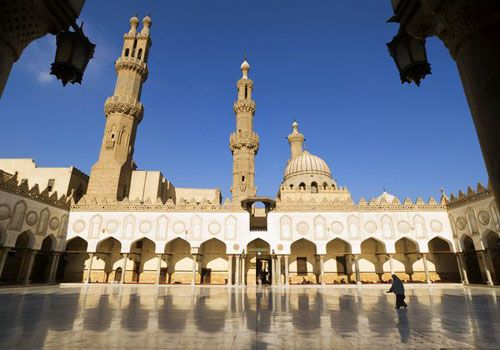
Al-Azhar Mosque in Cairo in Egypt is a fundamental Islamic monument with many dimensions. Constructed by the Caliph Al-Mu'izz li-Din Allah for the newly established capital city in 970, it was the first mosque established in Cairo, a city that has since gained the nickname "the city of a thousand minarets. In this article, we present a short history of the Al-Azhar mosque and its progressive transformation into one of the most influential centres of Islamic learning for more than a millennium.
1. Introduction
Al-Azhar (Jamiat al-Azhar in Arabic) is today the most important religious university in the Muslim world with as many as 90,000 students studying there at any one time. It is arguably one of the chief centres Islamic learning and the greatest and the most influential in the Sunni Islamic world.
Figure 1: Exterior view of al-Azhar Mosque in Cairo: From left to right the minarets of Al-Ghuri, Qaytbay, Aqbaghawiyya, and Katkhuda. Photo taken in July 2008 by Daniel Mayer. (Source).
As a chief centre of Islamic and Arabic learning in the world, the complex of Al-Azhar centred on the mosque of that name in the medieval quarter of Cairo, Egypt. It was founded by the Fatimids in 970 CE and was formally organized by 988. Its name may allude to Fatimah, the Prophet's daughter, known as "al-Zahra" ("the Luminous"), from whom the Fatimid dynasty derives its name. The format of education at al-Azhar remained relatively informal for much of its early history: initially there were no entrance requirements, no formal curriculum, and no degrees. The basic program of studies was—and still is—Islamic law, theology, and the Arabic language.
Al-Azhar fell into eclipse after Egypt's conquer by Salah al-Din (Saladin), founder of the Ayyubid dynasty and in the second half of the 12th century it became a centre of a Sunni learning. It was revived under the Mamluks (1250–1517), however, and continued to thrive thereafter as a centre of Sunni scholarship. It was damaged in an earthquake in the early 1300s and subsequently repaired, and additions, alterations, and renovations to its structures were undertaken at various points throughout the 14th and 15th centuries, particularly in the later Mamluk period, when it came under direct patronage.
2. History
When Jawhar the Sicilian, commander of the troops sent by the Fatimid Caliph Al-Mu'izz to conquer Egypt, founded Cairo in 358 H / 969 CE, he built Al-Azhar originally as a mosque. The mosque was completed within two years and opened for its first prayers on 7 Ramadan 361 H / June 22, 972 CE. Historians differ as to how the mosque got its name. Some hold that it is called as such because it was surrounded by flourishing mansions at the time when Cairo was founded. Others believe that it was named after "Fatima Al-Zahra" the daughter of Prophet Muhammad to glorify her name. This last explanation sounds the most likely, as the Fatimids named themselves after her.
During the Fatimid times (972-1171), Al-Azhar was a minor university whose objective was to spread the Shiite teachings in Egypt. Its position was thus important to the ruling Fatimid dynasty, but had little importance to the rest of the Muslim world who had its eyes focused on Baghdad as the centre of Islamic knowledge. Through the schools of Baghdad, Muslims got to know scholars of the calibre of Abu Hamid al-Ghazali, Abu Ishaq al-Isfara'ini, Al-Juwayni and Abu-Bakr Al-Baqilani. For the majority of Muslims, Al-Azhar was not as famous as the schools of Baghdad. In addition, the Fatimids were looked upon by the majority of Muslims as rulers belonging to a heretic sect. This view is obvious through the declaration made in Baghdad by many Muslim scholars denouncing the Fatimids. The declaration included prominent Sunni scholars like Abu Ishaq al-Isfara'ini in addition to prominent Shii scholars like al-Sharif al-Murtada. This stand regarding the Fatimids hampered Al-Azhar from taking a prominent position in the Islamic world during the time of the Fatimids.
When the Ayyubids assumed power, Al-Azhar was converted to the Sunni (mainstream) Islamic teachings. But with the establishment of the Ayyubid schools in Egypt, Al-Azhar's position in the Islamic world became of little importance. It was considered just another school among the many schools in Egypt, Baghdad, Syria and Andalusia.
Figure 2: View of the inner courtyard in Al-Azhar. (Source).
During the reign of the Mamluk sultan Baybars and at the hands of prime minister Izz al-Din Aydmer, Al-Azhar witnessed a rebirth that elevated it to become the highest ranking institution of Islamic education. Aydmer lived in a palace neighboring Al-Azhar. He proposed to Baybars a plan to renew the mosque. The sultan welcomed the idea and provided the funds necessary for refurbishing the mosque. Aydmer was aided by many Mamluk princes who offered their money for the mosque. Subsequently, Aydmer went further and proposed performing the main Friday prayer in Al-Azhar. After he had overcome the opposition to this step, he encouraged the scholars to use the mosque as their main educational institution. The support that Aydmer gave to Al-Azhar and the influx of Muslim scholars to Egypt made the Mamluk era, Al-Azhar's golden age.
Figure 3: The inner Mihrab of the Al-Azhar Mosque of Cairo. (Source).
The Islamic caliphate was looked upon as the symbol of Muslim unity in the Islamic world. After the defeat of the Mongols in Ayn Jalut, Sultan Baybars invited the Abbasid family, whose Caliphate which was destroyed earlier by the Mongols, to resume their office in Cairo. With this move, many of the Islamic scholars of the east migrated to Egypt (and in some cases to Syria) fleeing from the Mongol yoke. This immigration of Islamic scholars to Egypt was paralleled by another influx, but from the west. Many Islamic emirates in Andalusia (Spain) were overrun by the Castillan armies between 1236 and 1261 and the famous Islamic schools in Qurtuba (Cordoba), Ishbiliyya (Seville) and Balansiyya (Valencia) were destroyed. Since the Mamluk sutlanate was the most powerful state in the Muslim world at the time, Egypt became the pole of attraction for western influx of scholars.
3. Education
Al-Azhar University is a natural expansion of the great mosque of Al-Azhar. It is the most celebrated of all Islamic academic institutions and universities throughout the world. For over a thousand years, Al-Azhar has produced thousands of eminent scholars, distinguished educationalists, preserving Islamic heritage and strengthening Islamic identity.
During the Mamluk period, most of the prominent Muslim scholars of the time taught in Al-Azhar, or at least visited the institution for a brief period of time. The great care that was given to Al-Azhar by the Mamluk princes put the mosque in a position that was unequalled by any other Cairean mosque. At the same time, Al-Azhar had a curriculum of subjects that were regularly taught in it.
Some of the famous scholars who taught in Al-Azhar in the Mamluk period include:
● Abu al-'Abbas al-Qalqashandi
● Taqi al-Din Ahmad al-Maqrizi
● Ibn Hajjar al-'Asqalani
● Badr al-Din al-'Ayni
● Siraj al-Din al-Balqini
● Sharaf al-Din al-Munawi
● Abu al-Mahasin ibn-Taghribirdi
● Shams al-Din al-Sakhawi
● Jalal al-Din al-Suyuti
● Muhammad ibn Ahmad ibn Iyas
● Muhammad Taqi al-Din al-Fasi
● Abd al-Rahman ibn Khaldun
With the defeat of the Mamluks in 1517, substantial architectural projects were few until the mid-18th century; in spite of this, al-Azhar's significance continued, and under Ottoman rule it held preeminent status among Egyptian institutions of learning. Opposition to the French in the late 18th century led to an uprising in 1798 centred on al-Azhar, and as a result it was bombarded by the French and temporarily closed. 19th-century reform at al-Azhar was due in part to the involvement of a number of individuals, including Jamal al-Din al-Afghani, who taught at al-Azhar in the 1870s and emphasized that modern science and other subjects were not incompatible with the Quran, and Muhammad Abduh, who was influenced as a young intellectual by al-Afghani and later proposed, as a member of a government committee, a number of broad measures for reforming al-Azhar. In the late 19th century, procedures, including admission requirements and examinations, were formalized, and a number of modern subjects—some of them obligatory—were introduced.
Al-Azhar was nationalized and again underwent substantial reforms in the early 1960s. Since that time, faculties such as those of medicine and engineering have been established; women were first admitted in 1962. The modern university offers a number of faculties, some of them for women, as well as regional facilities.
Al-Azhar today continues to pride itself on teaching Qur'anic Sciences (‘Ulum al-Qur'an), Prophetic Traditions (Hadith), Theology (‘Ilm al-Kalam), Jurisprudence (Fiqh), Fundamentals (Usul), Arabic Grammar (Nahw), Conjugation (Sarf), Rhetoric (Balagha), Arabic Literature (Adab), History (Tarikh), Medicine (Tib), Philosophy (Falsafa) and Logic (Mantiq).
Frequently Asked Questions
Tiba Alarabya Institute is a specialist institute dedicated to teaching the classical Arabic language, Quran, and Islamic Sciences online.
We are located in Egypt.














